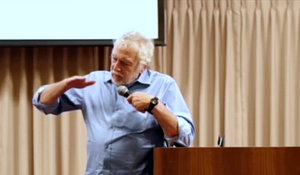Teachers at the 2012 International Go Symposium

The 2012 International Go Symposium in Black Mountain, North Carolina attracted leading scholars and researchers from around the world for two days of presentations and discussions on the many aspects of the game of go. Dozens of hours of footage have now been edited down and posted online to accompany the conference papers. This 3-part series covers highlights of Symposium presentations by teachers, scientists, historians and anthropologists.
Games may be a major key to learning, suggested keynote speaker Nolan Bushnell (up) at the 2012 International Go Symposium, August 4-5, 2012. The entrepreneurial wizard behind products as diverse as Atari and Chuck E. Cheese, Bushnell is now applying principles such as "thalamic engagement" and "spaced repetition" to develop Brainrush, a game-based learning app that aims to help students learn all kinds of material more effectively. Mexican Go Assoiation President Israel Rodriguez offered some interesting speculations on the nature of the barriers to developing a go culture. Yet go is a superb medium for growth and development, as Dr. Roy Laird – a clinical social worker who manages treatment programs for The Children's Aid Society in New York City and former President of the American Go Association – explores in his talk "Play Go And Grow," about the unique aspects of go that favor positive development, and some interesting recent research on go and the brain. While go is popular in Asian communities and has developed a growing base among Caucasians in the West, its presence is very limited in other Western cultures. In Playing Under and Pushing Through the Stones, Roxanna Duntley-Matos, a member of the Western Michigan University School of Social Work faculty, describes how she used go as a tool for "emancipatory education" with the Ann Arbor Hispanic community, promoting leadership, camaraderie and success among a marginalized minority. At the upper end of the learning spectrum, Peter Schumer described a for-credit course on go that he has taught at Middlebury College for years, offering tips on everything from curriculum development to teaching style.
.jpg) In "How Rules, Terms and Attitude Help or Hinder the Game,", American Go Foundation (AGF) President and AGA Rules Committee Chairman Terry Benson (left) urges a rethinking of what it means to "play go," and what we teach. Peter Freedman, an experienced go teacher from the Portland area, looked beyond simply teaching children the game to how to help them develop a lifelong love for go, while go teacher Siddhartha Avila's Mexican school is committed to teaching through the arts. On a practical level, AGF VP Paul Barchilon outlined some of the many ways that the AGF can help aspiring organizers in the US.Laura Martinez ended the go teacher's panel, and the conference, by unveiling the winners of The Second International Go Art Contest.
In "How Rules, Terms and Attitude Help or Hinder the Game,", American Go Foundation (AGF) President and AGA Rules Committee Chairman Terry Benson (left) urges a rethinking of what it means to "play go," and what we teach. Peter Freedman, an experienced go teacher from the Portland area, looked beyond simply teaching children the game to how to help them develop a lifelong love for go, while go teacher Siddhartha Avila's Mexican school is committed to teaching through the arts. On a practical level, AGF VP Paul Barchilon outlined some of the many ways that the AGF can help aspiring organizers in the US.Laura Martinez ended the go teacher's panel, and the conference, by unveiling the winners of The Second International Go Art Contest.The AGA and the 2012 US Go Congress are extremely grateful to theInternational Go Federation for financial support that made this event possible, and to the American Go Foundation for additional support. All presentations can be found at the Symposium's YouTube channel. In addition, links to all the videos and to associated papers, links and contact information be found at the Symposium website. NEXT WEEK: Historians and anthropologists at the Symposium.
- Source from American Go E-Journal
New update
